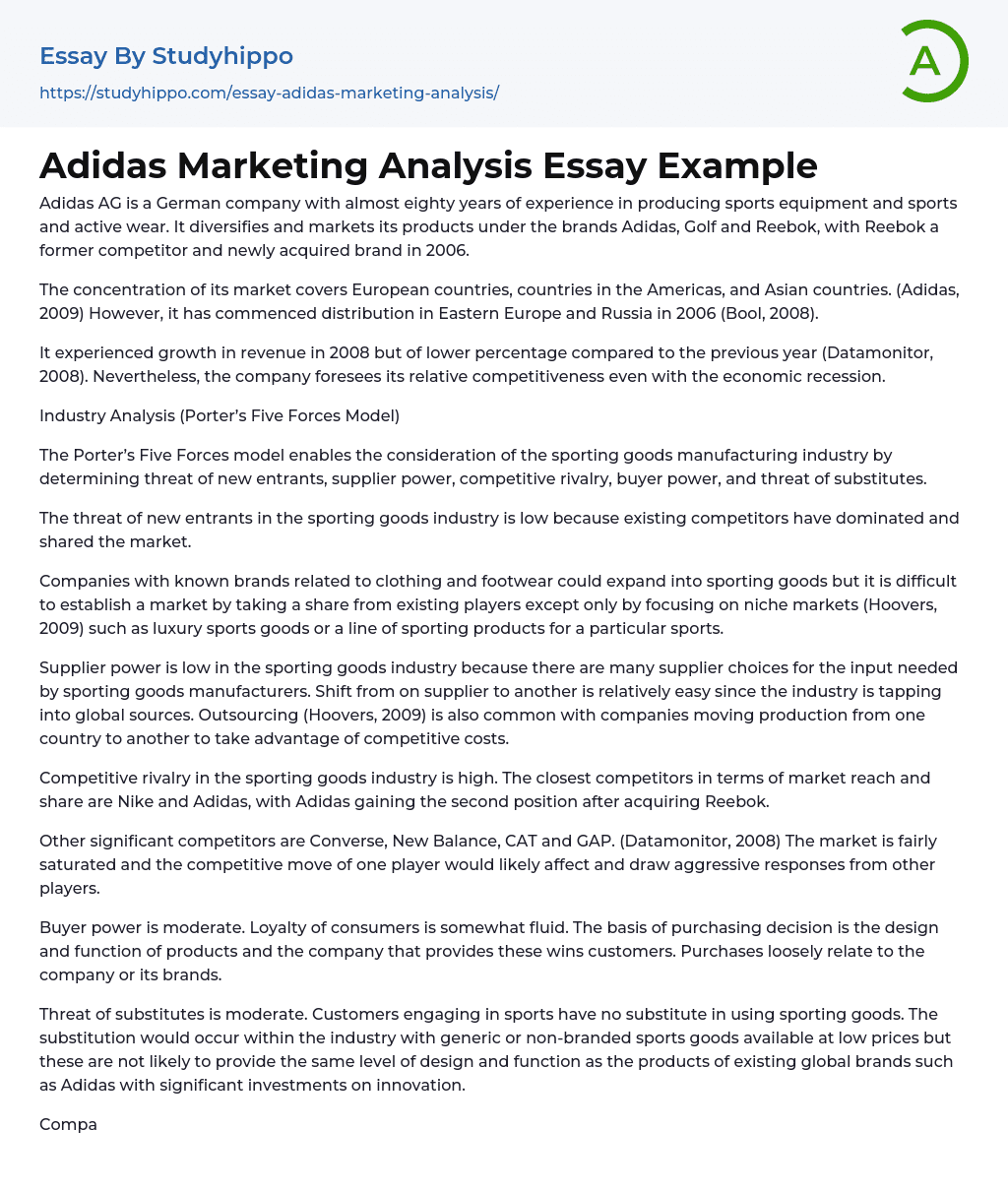Adidas AG is a German company with almost eighty years of experience in producing sports equipment and sports and active wear. It diversifies and markets its products under the brands Adidas, Golf and Reebok, with Reebok a former competitor and newly acquired brand in 2006.
The concentration of its market covers European countries, countries in the Americas, and Asian countries. (Adidas, 2009) However, it has commenced distribution in Eastern Europe and Russia in 2006 (Bool, 2008).
It experienced growth in revenue in 2008 but of lower percentage compared to the previous year (Datamonitor, 2008). Nevertheless, the company foresees its relative competitiveness even with the economic recession.
Industry Analysis (Porter’s Five Forces Model)
The Porter’s Five Forces model enables the considera
...tion of the sporting goods manufacturing industry by determining threat of new entrants, supplier power, competitive rivalry, buyer power, and threat of substitutes.
The threat of new entrants in the sporting goods industry is low because existing competitors have dominated and shared the market.
Companies with known brands related to clothing and footwear could expand into sporting goods but it is difficult to establish a market by taking a share from existing players except only by focusing on niche markets (Hoovers, 2009) such as luxury sports goods or a line of sporting products for a particular sports.
Supplier power is low in the sporting goods industry because there are many supplier choices for the input needed by sporting goods manufacturers. Shift from on supplier to another is relatively easy since the industry is tapping into global sources. Outsourcing (Hoovers, 2009) is also common with companie
moving production from one country to another to take advantage of competitive costs.
Competitive rivalry in the sporting goods industry is high. The closest competitors in terms of market reach and share are Nike and Adidas, with Adidas gaining the second position after acquiring Reebok.
Other significant competitors are Converse, New Balance, CAT and GAP. (Datamonitor, 2008) The market is fairly saturated and the competitive move of one player would likely affect and draw aggressive responses from other players.
Buyer power is moderate. Loyalty of consumers is somewhat fluid. The basis of purchasing decision is the design and function of products and the company that provides these wins customers. Purchases loosely relate to the company or its brands.
Threat of substitutes is moderate. Customers engaging in sports have no substitute in using sporting goods. The substitution would occur within the industry with generic or non-branded sports goods available at low prices but these are not likely to provide the same level of design and function as the products of existing global brands such as Adidas with significant investments on innovation.
Company Strategy
The strategy of Adidas is product differentiation and diversification. It aims for differentiation in terms of product development, product portfolio diversification, and brand building. Adidas invests in product design and technological innovation for enhanced function and on product customization technology for customers to pimp their Adidas shoes.
It also targets expansion to different regions to tap into new markets. It also continues to invest on advertising, particularly celebrity endorsement. (Adidas, 2009) By doing so, Adidas expects to gain a bigger share from the market by taking
a portion from Nike and possibly even become the leader in the sporting goods industry.
SWOT Analysis
The SWOT analysis identifies the internal strengths and weaknesses as well as external opportunities and threats faced by Adidas. The strength of Adidas is having the largest pool of celebrity endorsers excelling in different sports representing the brand. The company can tap into its pool of celebrity endorsers to build its brand. Its weakness is the lesser impact of its brand equity relative to Nike the industry leader.
Nike’s slogan ‘Just do it.’ has a stronger market impact because its cool and more sports enthusiasts can relate to it when compared to Adidas’ slogan of ‘Impossible is Nothing.’ An opportunity is market expansion as first mover in untapped markets. This is the only way for Adidas to increase its market share. The threat is customer shifting with the intensifying aggressiveness other industry players.
Conclusion
Adidas is on the right track in pursuing differentiation and diversification as strategy. However, it has to reinforce its strength and address its weakness as well as tap into the expansion opportunity to enhance its competitive position globally.
References
Adidas. (2009). About us. Retrieved May 2, 2009, from http://www.adidas.com/ph/shared/aboutadidas.asp
Bool, H. (2008). Company profiles – Adidas. Retrieved May 2, 2009, from http://ezinearticles.com/?Company-Profiles---Adidas&id=1309652
Datamonitor. (2008). Adidas AG – SWOT analysis. Retrieved May 2, 2009, from http://www.marketresearch.com/product/display.asp?productid=2192158&xs=r&SID=37765513-441271052-403505797&curr=USD&kw=&view=abs
Hoovers. (2009). Sporting goods manufacturing. Retrieved May 2, 2009, from http://www.hoovers.com/sporting-goods-manufacturing/--ID__361--/free-ind-fr-profile-basic.xhtml
- Wal-Mart essays
- Discover essays
- Adidas essays
- Amazon essays
- Apple essays
- Bmw essays
- British Airways essays
- Burger King essays
- Coca-Cola essays
- Company essays
- Costco essays
- Dell essays
- Ebay essays
- Enron essays
- Facebook essays
- Ford Motor Company essays
- Gap essays
- General Motors essays
- Google essays
- Honda essays
- Ibm essays
- Ikea essays
- Intel essays
- Iphone essays
- Johnson and Johnson essays
- Kellogg essays
- Key essays
- Kfc essays
- Mcdonald's essays
- Microsoft essays
- Myspace essays
- Nestle essays
- Netflix essays
- Nike essays
- Nokia essays
- Pepsi essays
- Pepsico essays
- Red Bull essays
- Ryanair essays
- Samsung essays
- Sony essays
- Southwest Airlines essays
- Starbucks essays
- Supermarket essays
- Tesco essays
- Toyota essays
- Twitter essays
- Volkswagen essays
- Walmart essays
- Advertisement essays




